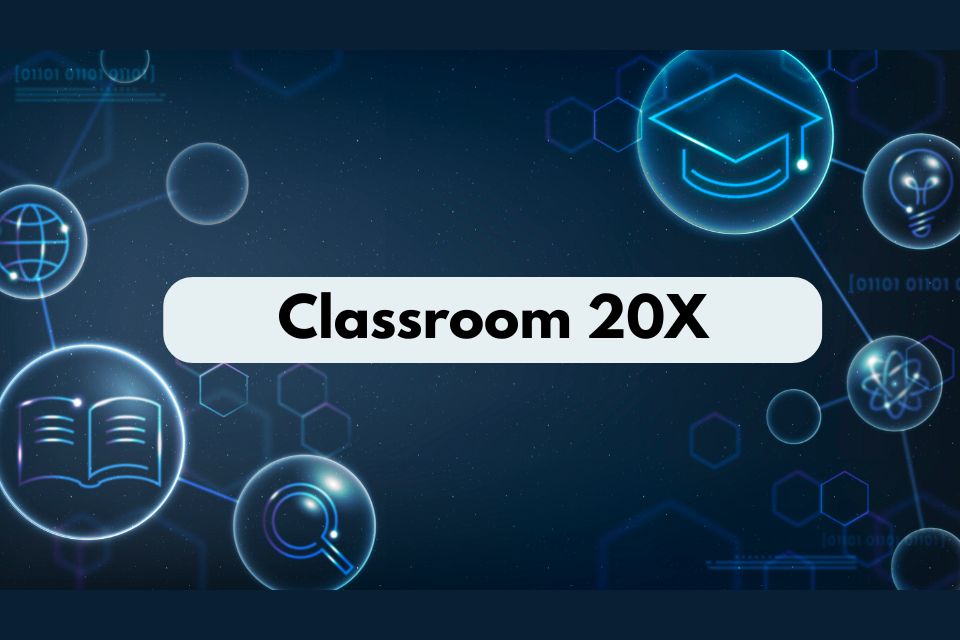Classroom 20X is a model of education that incorporates technology, instruction, and student-centered learning. It does not simply mean possessing smartboards or tablets. It is all about transforming the way students are learning and the way teachers are teaching.
Visualize a classroom that is flexible to the needs of each student, where the classroom is interactive, and where learning is conducted online and in the real classroom. The best part? It allows the students to develop such skills as creativity, collaboration, and critical thinking, as opposed to memorizing facts.
Want to see how this works in real life? Read on to know how it’s more than ideas.
Table of Contents
What Is Classroom 20X & Why does It Matter?
This is because students become bored when classes are in the same format: lecture, notes, test. This one-size-fits-all style lacks individuals who have different learning styles. Classroom 20X is important as it tries to address that. It is supposed to involve students, allow them to learn at their pace, and provide the teachers with tools to support learning in a more equitable manner.
In addition, education must be prepared with transformations such as remote learning, demanding new job requirements, and technology all around. Classroom 20X comes in to ensure that learning is more flexible, relevant and inclusive.
Which Technologies Power Classroom 20X?
The following are the key technological resources that help Classroom 20X to be effective:
Artificial intelligence (AI) & Machine Learning: They monitor the areas the students have trouble with and propose resources, modify the difficulty, or assist teachers in pinpointing weak points.
Virtual Reality (VR) and Augmented Reality (AR): students have an opportunity to visit virtual historical locations, observe living bodies in biology, or perform science experiments in the immersive mode.
Learning Analytics Dashboards: These provide real-time information of the performance of individual students. Teachers are able to step in when issues become too large.
Internet of Things (IoT) and Smart Classrooms: The IoT provides sensors, environmental control, cloud-based storage, digital attendance, etc. and allow making classrooms safer, more responsive, and more efficient.
Classroom 20X Vs. Old Classrooms
The following are the features of many Classroom 20X models:
- Provide pathways of adaptive learning so as to allow students to learn at a pace they feel comfortable with.
- Online modules, virtual classes, and face-to-face learning mixed to create blended and hybrid learning.
- Engaging interactive material such as simulations, gamified tests, AR/VR activities that make the lessons more interactive.
- Adaptable learning areas through class organization into group work, collaborative areas, silent studies, etc.
How Do Students & Teachers Benefit From Classroom 20X?
Students get more than technology devices. This is how Classroom 20X can benefit both parties:
- Greater interaction: The lessons are more interactive; the students are not passive listeners.
- One-on-one Assistance: Students with special needs are provided with assistance early; students with higher ability receive more challenge.
- Better Learning Results: Due to better comprehension and motivation, the grades and understanding of students usually increase.
- Teacher Empowerment: Less time spent on routine tasks like grading or attendance; more time on mentoring, creativity, planning.
- Inclusivity and Equity: Tools for students with special needs; language supports; remote access helps students far from school.
What Challenges Does Classroom 20X Face?
The following are some of the major pitfalls and how individuals attempt to overcome them:
- Cost and Infrastructure: Not all schools can buy VR headsets or reliable internet.
Solution: start small, use low-cost tools, phase in tech.
- Teacher Training: many educators aren’t used to adaptive tools, gamified content, or data analytics.
Solution: Ongoing professional development, peer support.
- Digital Divide: Students in rural or low-income areas may lack devices or internet.
Solution: Government or NGO assistance; communal devices; off-line content.
- Privacy and Ethics: Gathering learning data is associated with issues of student safety and misuse.
Solution: Clear policies, parental consent, secure tech.
What Does The Future Look Like With Classroom 20X?
Further into the future, immersive technology, AI, and student-centric design will be combined in more schools. The process of learning can become more personal. The task of the teacher will change to a more guiding and mentoring role.
The classroom area itself can appear quite different, not as strict rows, but with more areas of various kinds of learning. Finally, Classroom 20X is also designed to equip students with more than exams, but also with a world that is evolving and requires flexibility, innovation and teamwork.
Wrap Up
Classroom 20X isn’t just a buzzword. It is a means of making learning significant, exciting and equitable to all students. It combines intelligent tools and effective instructional concepts. The disadvantages are present, but the advantages are powerful and increasing. Providing schools spend their money wisely, and teachers are ready to change, Classroom 20X can actually transform the way we learn.


